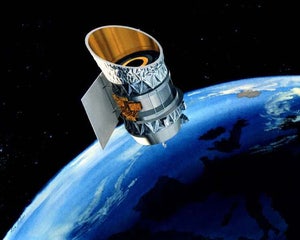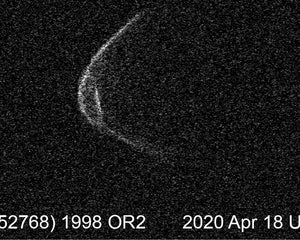21-Ton Chinese Rocket is Plummeting Back to Earth and Will Land… Somewhereon May 3, 2021 at 9:18 pm

It could fall on a number of cities.
There’s a 21-ton out-of-control rocket falling back to Earth — and no one is quite sure where it’s going to land.
According to experts, the uncontrolled re-entry could happen above any one of a number of population centers across the world.
On Thursday, China announced the successful launch of the Tianhe module of the new space station it is building; and it was successful, in that the module made it to space.
However, the 100 ft long and 16 ft wide rocket that carried it there continued on into space, too. Instead of falling back into a predetermined spot in the ocean like booster rockets usually do, the Long March 5B made it into orbit… for the time being.
Now experts are saying it is headed back to Earth in the coming days, but no one quite knows when or where.
Because the Earth is made up mostly of ocean, chances are it will land — somewhere — in the water. But there is also the chance it could fall onto an inhabited area, including any city from New York in the northern hemisphere to Wellington New Zealand, in the southern.
It is currently doing laps of the Earth every 90 minutes — that’s traveling at almost 5 miles per second — and getting closer and closer with each orbit. Because it is moving so fast, it is almost impossible to predict the point it will re-enter the atmosphere and hurtle to Earth: A difference of seconds up there means a difference of hundreds of miles down here.
China also launched a Long March 5B in May of last year, and it also made its return journey via uncontrolled re-entry, which at the time drew criticism from NASA.
It missed the United States by just 15 minutes, but had been circling the planet so fast it ended up crashing in Cote d’Ivoire in Africa, thousands of miles away.
According to astronomer Jonathan McDowell, who is tracking the space debris, before that launch nothing over 10 tons had been deliberately left in orbit to re-enter uncontrolled since 1990.
He told SpaceNews that after last year’s near miss, he’d hoped China would have improved it’s core stage rocket and take control of future re-entries.
“I think by current standards it’s unacceptable to let it re-enter uncontrolled,” he said.
While the entire thing may burn up on re-entry, there is a chance some components — like its massive motors — will survive and impact the Earth.
“It is always difficult to assess the amount of surviving mass and number of fragments without knowing the design of the object, but a reasonable ‘rule-of-thumb’ is about 20-40 percent of the original dry mass,” McDowell added.
The newly formed US Space Force is monitoring the situation; but because it is moving erratically at more than 15,000 MPH, they may only have a one or possibly two hour warning window by the time they figure out its landing spot.
It could fall on a number of cities.
There’s a 21-ton out-of-control rocket falling back to Earth — and no one is quite sure where it’s going to land.
According to experts, the uncontrolled re-entry could happen above any one of a number of population centers across the world.
On Thursday, China announced the successful launch of the Tianhe module of the new space station it is building; and it was successful, in that the module made it to space.

Getty
Elon Musk Hosting Saturday Night Live, Twitter Explodes
View Story
However, the 100 ft long and 16 ft wide rocket that carried it there continued on into space, too. Instead of falling back into a predetermined spot in the ocean like booster rockets usually do, the Long March 5B made it into orbit… for the time being.
Now experts are saying it is headed back to Earth in the coming days, but no one quite knows when or where.
Because the Earth is made up mostly of ocean, chances are it will land — somewhere — in the water. But there is also the chance it could fall onto an inhabited area, including any city from New York in the northern hemisphere to Wellington New Zealand, in the southern.
It is currently doing laps of the Earth every 90 minutes — that’s traveling at almost 5 miles per second — and getting closer and closer with each orbit. Because it is moving so fast, it is almost impossible to predict the point it will re-enter the atmosphere and hurtle to Earth: A difference of seconds up there means a difference of hundreds of miles down here.
China also launched a Long March 5B in May of last year, and it also made its return journey via uncontrolled re-entry, which at the time drew criticism from NASA.

NASA (pictured: IRAS)
Two Satellites Could Collide Above The US Tonight — Why It’s Bad News
View Story
It missed the United States by just 15 minutes, but had been circling the planet so fast it ended up crashing in Cote d’Ivoire in Africa, thousands of miles away.
According to astronomer Jonathan McDowell, who is tracking the space debris, before that launch nothing over 10 tons had been deliberately left in orbit to re-enter uncontrolled since 1990.
He told SpaceNews that after last year’s near miss, he’d hoped China would have improved it’s core stage rocket and take control of future re-entries.
“I think by current standards it’s unacceptable to let it re-enter uncontrolled,” he said.
While the entire thing may burn up on re-entry, there is a chance some components — like its massive motors — will survive and impact the Earth.
“It is always difficult to assess the amount of surviving mass and number of fragments without knowing the design of the object, but a reasonable ‘rule-of-thumb’ is about 20-40 percent of the original dry mass,” McDowell added.
The newly formed US Space Force is monitoring the situation; but because it is moving erratically at more than 15,000 MPH, they may only have a one or possibly two hour warning window by the time they figure out its landing spot.

ARECIBO OBSERVATORY/NASA/NSF
Asteroid Visiting Earth’s Orbit ‘Remembered to Wear a Mask’, Says Scientist
View Story
